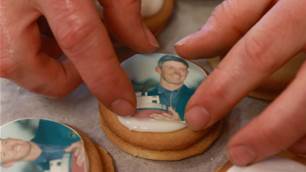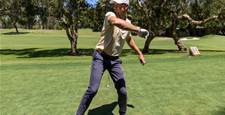Tired of a golf game where your niggling back or hip dictates how you swing from round to round? English professional Reeves Weedon believes the best way to avoid golf injuries is to change the focus of your swing and has developed the ‘Lower Body Swing’ with outstanding results.
The summer is over in London, but despite the cooling weather the Greenwich Driving Range is full during the weekends as players of all ages and skills hit bucket after bucket out onto the netted fairway with its views across the River Thames to silver office blocks of Canary Wharf.
Weedon teaches here five days a week. The giant arms of a mechanical golfing machine known as ‘RoboGolf’ dominate his bay. Weedon can program the machine to enable students to swing like any player they choose, from Sergio and Seve to Dustin and Brooks, but Weedon leaves it covered most of the time, preferring to teach by eye rather than by robotics.
He is a big bloke with a genial manner in his mid-50s, and one senses a wistfulness about a career he might have had if not for youth and injuries, which put paid to life as a touring pro.
“I was supposed to be the next Peter Oosterhuis,” he says of his successful amateur career in the mid-1970s and early 1980s during which he captained England several times. Instead, he gave it up, jaded and with a bad back by the age of 22, probably caused by his tall and elegant swing. He ended up selling golf equipment for the next seven years until he realised he’d made the wrong decision and returned to the game he loved, but this time as a teaching professional.
“It was one of those stories,” he says. “I was actually offered a sponsorship at the age of 16. I said ‘no’. I suppose things might have been different for me playing-wise if I’d known at the time what it meant and what opportunities it would have opened up for me.
“But you can’t live with regret and I love teaching,” he adds hastily. “To be honest, I was disappointed in what I discovered about the teaching profession. A lot of what is being taught about the golf swing is simply about who is the best showman and who has the best patter, and very little about helping people play better – and more safely.”
And that’s where his ideas are focused.
“I got a text the other day from Lorin Anderson, a senior US golf television executive at The Golf Channel, who told me that what we’re doing has huge implications because there were more than 50 million rounds of golf lost in the US each year because of injured players. 50 million. It’s unbelievable.”
So how does the Lower Body Swing work?
There are two pictures to build into your mind, first that rather than swinging the club in an arc around the body with weight shifting back and forth between the left and right sides, the movement is actually more like a walking motion – from toe-to-heel on the way back and then heel-to-toe on the way through – while the weight stays almost entirely on the left side.
“The ground powers the golf swing,” says Weedon. “The more mass you push into the ground the greater the momentum. A toe-to-heel then heel-to-toe weight shift, which feeds down to up, creates twice as much body rotation than the traditional modern golf swing and it means no tilting or bending of the back, so it creates little or no torque on the spine and helps prevent lower back injury.”
THE LOWER BODY SWING
Flexion and extension of the legs creates a toe-to-heel/heel-to-toe weight shift. The feeling is down and left with forces going to the ball. The glutes have the same motion as the back.
In the Lower Body Swing (LBS), the knees lead the hips and the hips lead the shoulders (pics 3 & 4), which is completely opposite to the modern swing where the shoulders lead the hips, hips lead the knees and there’s no left foot rolling.
Take note of the position of the left arm, which – according to Weedon – is ideally below the level of the right shoulder (pic 4).
There has been no lateral hip shift, which creates minimal spinal load. Also, the ankles, knees, hips and shoulders are more in line with each other, which is created by the legs pushing up on the downswing, replacing the common lateral hip slide.
Finally, there is no strain on the spine in the follow-through (pic 6).
The LBS is biomechanically correct. The swing is about what the body wants to do, not what golf says the body should do.

Jack Harris, an emeritus professor of biology at Sages Colleges outside New York who began working with Weedon seven years ago, says little thought has been given to coaching ageing golfers despite the fact an estimated 60 percent are aged over 50:
“An approach to working with senior golfers, and ideally, all golfers, should meet four criteria,” he says. “It must be protective of the body, it must produce effective shots, it must serve both men and women and it must be easy to learn.
“Reeves’ approach to the golf swing addresses these criteria, and unlike many other approaches to the golf swing, scientific investigations have documented the efficacy of his ideas.
“The Lower Body Swing is based on a fundamental fact of physics: all power ultimately comes from ground force couples, that is, from pushing on the ground. It is a whole body motion that doesn’t require special moves to get the club on plane, or preserve loft, or create lag. Consequently, the lower body swing offers maximum clubhead speed for input effort through efficient, and timely, transmission of force to the clubhead. Unlike other swing approaches for senior golfers, the lower body swing directs the golfer’s attention to the movements that physics says powers the ball.
“It is highly effective for women because women have most of their strength in their lower bodies. This is especially important for women beginners, who often struggle to get the ball in the air using conventional technique. Using the lower body swing, women beginners get the ball in the air, and moving, in their first lesson.
“On the other end of the spectrum, experienced men and women may hit the ball in the air a long way, but often struggle to control where it is going. Because the lower body swing creates power with an on-axis body, experienced players improve their accuracy when they use the lower body swing. Furthermore, because the lower body swing pays attention to the locus of power, that is, the interaction of the body with the ground, expert golfers who import the concept into their practice find they don’t suffer loss of distance as much as might be expected while aging, and gain body-preserving mechanics.
“Finally, it is easy to learn. Most people only require one lesson to understand the feel of the lower body swing. And when applied to golf ball, the effects of simple movement can be startling. It is not unusual for a golfer at his or her first lesson to stare wide mouthed at a ball that has just exploded down the fairway, with a gentle draw, after the seemingly simple movement of a lower body swing.”
A USEFUL DRILL
Here is a drill to get your legs starting the golf swing’s kinematic sequence. The simultaneous flexion and extension of the legs (pics 1 & 3) is clearly seen here.
The ground is powering the swing. The feet move the knees, the knees move the hips, the hips move the shoulders, the shoulders move the arms, the arms move the club and the club moves the ball.
This drill encourages every joint in your body to work in line with each other.

Joe Miller, a two-time world long driving champion who regularly hits the ball over 400 yards, has also sought Weedon’s help with accuracy:
“Reeves suggested that my body mass would move quicker if I maintained a better connection with the ground,” Miller wrote of the experience. “He taught me a pronounced front-to-back/back-to/front weight shift which kept me centred and minimised power leakage. It gave me a feeling of pushing down on the backswing and up off the ground on the downswing.
“Reeves also encouraged me to keep my left arm under my right shoulder, a position that would allow me to rotate quicker. This promotes two feelings that I like: The first is that I’m literally hitting the ball with my body and the arms are just going along for the ride. And secondly, I feel that I can turn as hard and as swiftly as possible and the clubhead will strike the ball dead, solid perfect – which to me means long and straight.”
Reeves Weedon is based in London but is happy to hear from any golfers or teachers interested in Lower Body Swing. He can be reached at reevesweedon@aol.com. Weedon would like to thank Callaway Golf for its support in the prevention of lower back injuries in golf.
Related Articles

Rory then Day-light, but Aussie still has hope

Hero World Challenge field spotlights Australian Open hurdle and OWGR prospects












